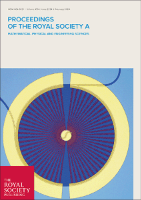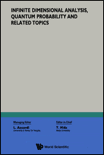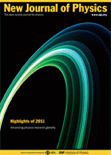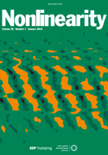
JOURNAL OF STATISTICAL PHYSICS
metrics 2024
Advancing the frontiers of Statistical and Nonlinear Physics.
Introduction
The Journal of Statistical Physics, published by Springer, is a premier academic journal that has made significant contributions to the fields of Mathematical Physics and Statistical and Nonlinear Physics since its inception in 1969. With a strong reputation reflected in its 2023 rankings—placing it in Q2 of both categories and achieving an impressive Scopus rank of #22 in Mathematical Physics and #25 in Statistical and Nonlinear Physics—this journal serves as a vital platform for researchers, professionals, and students. The impact factor of the journal underscores its importance in disseminating cutting-edge research and theoretical developments. Authors are invited to submit original research articles that explore the intricate complexities of statistical mechanics, quantum physics, and related disciplines, fostering deep insights and academic discourse. Although the journal does not currently offer open access, its robust editorial standards and commitment to advancing knowledge make it an essential resource for those engaged in these dynamic fields.
Metrics 2024
 0.80
0.80 1.30
1.30 1.50
1.50 117
117Metrics History
Rank 2024
Scopus
IF (Web Of Science)
JCI (Web Of Science)
Quartile History
Similar Journals

PROCEEDINGS OF THE ROYAL SOCIETY A-MATHEMATICAL PHYSICAL AND ENGINEERING SCIENCES
Pioneering Discoveries in Mathematics, Engineering, and Physics.PROCEEDINGS OF THE ROYAL SOCIETY A-MATHEMATICAL PHYSICAL AND ENGINEERING SCIENCES is a prestigious academic journal published by the Royal Society in the United Kingdom, dedicated to the dissemination of high-quality research in the fields of Mathematics, Engineering, and Physics. With an esteemed impact factor and ranked in the top quartiles (Q1) across various categories, this journal stands out as a leading source of innovative findings and critical discussions within the global scientific community. Researchers benefit from its comprehensive coverage that spans from theoretical explorations to practical applications, and the journal plays a crucial role in advancing knowledge and fostering interdisciplinary collaboration. Although it does not currently offer Open Access options, its influence is underscored by notable Scopus rankings, evidencing its significant contribution to the fields it represents. Located at 6-9 Carlton House Terrace, London SW1Y 5AG, England, the journal continues to be a cornerstone for scholars seeking to publish impactful research and stay informed on the latest advancements in science and engineering.

Nonlinear Phenomena in Complex Systems
Transforming Insights into Nonlinear ChallengesNonlinear Phenomena in Complex Systems, published by BELARUSSIAN STATE UNIV, JOINT INST POWER & NUCLEAR RESEARCH, is an emerging platform dedicated to advancing the understanding of nonlinear phenomena within complex systems. With an ISSN of 1561-4085 and an E-ISSN of 1817-2458, this journal serves as a vital resource for researchers spanning the fields of mathematical physics and statistical and nonlinear physics. While classified within the Q4 quartile for both disciplines as of 2023, we encourage authors to submit impactful research that addresses the intricacies and challenges presented by complex systems, which are pivotal in various scientific applications. Targeting an international audience, including researchers, professionals, and students, the journal aspires to foster collaboration and innovation by offering open access to its insightful articles. With a converged publication timeline from 2009 to 2024, Nonlinear Phenomena in Complex Systems is poised to become a significant contributor to the evolving dialogue around nonlinear dynamics and their implications across multiple scientific domains.

Physical Review Research
Illuminating the path of scientific exploration.Physical Review Research, published by the American Physical Society, is a premier open access journal dedicated to the dissemination of high-quality research across all areas of physics and astronomy. Since its inception in 2019, this journal has quickly established itself as a vital platform for researchers, achieving a prestigious Q1 ranking in the dynamics of Physics and Astronomy (miscellaneous) and holding a commendable position in the Scopus Rankings with a rank of #29 out of 243, placing it in the 88th percentile. With the commitment to fostering scientific collaboration and transparency, Physical Review Research offers unrestricted access to valuable findings, enabling researchers, professionals, and students alike to engage with cutting-edge contributions in general physics and astronomy. As it converges into its forthcoming years of publication, the journal remains dedicated to showcasing rigorous research and innovative ideas that drive the field forward.

REVIEWS IN MATHEMATICAL PHYSICS
Fostering Insightful Analyses in Mathematical PhysicsREVIEWS IN MATHEMATICAL PHYSICS is a premier scholarly journal published by WORLD SCIENTIFIC PUBL CO PTE LTD, focusing on the versatile and dynamic field of mathematical physics. Established in 1996, this journal has quickly become a pivotal resource for researchers and professionals seeking in-depth analyses and reviews of contemporary advancements in both mathematical and statistical physics. With an impressive categorization in Q2 for both Mathematical Physics and Statistical and Nonlinear Physics as of 2023, it ranks among the top in its field, boasting a Scopus Rank of #27 in Mathematical Physics and #29 in Statistical and Nonlinear Physics. While currently not available as an open-access platform, the journal remains valuable for its rigorous peer-reviewed articles that aim to bridge the gap between theoretical aspects and practical applications in physics. Given its significant influence—evidenced by a robust footprint in the academic community—REVIEWS IN MATHEMATICAL PHYSICS is essential reading for anyone dedicated to advancing their knowledge and understanding of complex physical phenomena.

INFINITE DIMENSIONAL ANALYSIS QUANTUM PROBABILITY AND RELATED TOPICS
Nurturing Collaboration in Quantum Probability ResearchINFINITE DIMENSIONAL ANALYSIS QUANTUM PROBABILITY AND RELATED TOPICS, published by WORLD SCIENTIFIC PUBL CO PTE LTD, is a key academic journal dedicated to the exploration of advanced themes in applied mathematics, mathematical physics, and quantum probability. Since its inception in 1998, the journal has established itself as a critical resource for researchers and professionals in these interdisciplinary fields, currently standing in the third quartile according to the 2023 category rankings. Scholars can access a wealth of rigorous articles that delve into infinite dimensional analysis, providing valuable insights pertinent to statistical and nonlinear physics, and offering a platform for pioneering research. This journal not only bridges theoretical frameworks and practical applications but also nurtures a collaborative environment for emerging and established scholars. Through its commitment to advancing knowledge, INFINITE DIMENSIONAL ANALYSIS QUANTUM PROBABILITY AND RELATED TOPICS serves as an indispensable tool for anyone engaged in the forefront of quantum probability research.

NEW JOURNAL OF PHYSICS
Empowering researchers with open-access knowledge.NEW JOURNAL OF PHYSICS, published by IOP Publishing Ltd, is a prestigious open-access journal that has been at the forefront of the physics community since its inception in 1998. With an impact factor that places it in the Q1 category of Physics and Astronomy (miscellaneous) and a commendable ranking of #49 out of 243 in the general physics and astronomy category according to Scopus, this journal is recognized for its significant contribution to advancing research in the field. The journal caters to a broad scope of topics, providing a platform for the dissemination of cutting-edge research findings and innovative theoretical explorations. Operating from the United Kingdom, it offers a truly international perspective, making its contents accessible and impactful to a global audience. With robust open-access options, the NEW JOURNAL OF PHYSICS ensures that research findings are freely available, promoting collaboration and knowledge sharing among researchers, professionals, and students alike. This commitment to accessibility, combined with its high-quality content, makes it an essential resource for anyone engaged in the physics community.

CHINESE PHYSICS LETTERS
Connecting Theory and Experiment in PhysicsChinese Physics Letters is a prestigious journal published by IOP Publishing Ltd, based in the United Kingdom. Since its inception in 1984, the journal has served as a vital platform for disseminating impactful research in the field of physics, achieving a noteworthy Q1 ranking in the category of Physics and Astronomy (miscellaneous) as of 2023. Renowned for its rapid publication process, this journal is dedicated to providing a forum for high-quality, concise articles that address innovative theoretical and experimental findings relevant to both the academic community and industry practitioners. With an impressive Scopus rank of #52 out of 243, placing it in the 78th percentile, Chinese Physics Letters continues to influence the global physics landscape. Researchers, professionals, and students alike find this journal indispensable for staying abreast of the latest developments and trends in physics.

NONLINEARITY
Bridging Disciplines Through Nonlinear ExplorationNONLINEARITY is a premier academic journal published by IOP Publishing Ltd, dedicated to advancing the field of complex systems through the lens of nonlinear science. Since its inception in 1988, the journal has established itself as a vital resource for researchers and professionals alike, offering a robust platform for disseminating high-quality research in areas such as applied mathematics, mathematical physics, and statistical and nonlinear physics. With an impressive Q1 ranking across multiple pertinent categories, including Applied Mathematics and Mathematical Physics, NONLINEARITY ranks among the top journals globally, making it essential reading for those seeking to deepen their understanding of nonlinear phenomena. Although it does not operate under an open-access model, its rich repository of rigorous articles significantly contributes to academia, fostering innovative thought and facilitating cutting-edge research. Located in the heart of the United Kingdom at TEMPLE CIRCUS, TEMPLE WAY, BRISTOL BS1 6BE, NONLINEARITY continues to be at the forefront of the scientific community, championing new discoveries and interdisciplinary dialogue within its dynamic scope.

RUSSIAN JOURNAL OF MATHEMATICAL PHYSICS
Connecting Theories to Applications in Mathematical PhysicsRUSSIAN JOURNAL OF MATHEMATICAL PHYSICS is a premier academic journal published by PLEIADES PUBLISHING INC, dedicated to advancing the fields of mathematical physics and statistical and nonlinear physics. With a commendable Impact Factor in the Q2 category for both disciplines as of 2023, the journal serves as an essential platform for researchers, professionals, and students to explore innovative theoretical and applied aspects of these fields. Established between 1996 and 1997, and resuming publication in 1999 through to 2024, the journal reflects a long-standing commitment to disseminating high-quality scholarship. The Scopus rankings place it at a competitive position, ranking #23 out of 85 in Mathematical Physics and #26 out of 62 in Statistical and Nonlinear Physics, showcasing its relevance and influence. While currently not offering open access, the journal’s audience is encouraged to engage with its substantive research and contribute to the ongoing dialogue in mathematical physics, fostering a deeper understanding of complex physical phenomena.

INTERNATIONAL JOURNAL OF MODERN PHYSICS A
Fostering collaboration in the realms of astrophysics and high energy physics.INTERNATIONAL JOURNAL OF MODERN PHYSICS A, published by WORLD SCIENTIFIC PUBL CO PTE LTD, stands as a pivotal platform in advancing the frontiers of research within the fields of Astronomy and Astrophysics, Atomic and Molecular Physics, and Nuclear and High Energy Physics. Established in 1989, this journal has systematically contributed to the scientific community, with a demonstrated impact as indicated by its Q2 category rankings across these critical disciplines in 2023. Researchers and professionals are encouraged to engage with its rigorous peer-reviewed content, fostering a deeper understanding of modern physics theories and experimental breakthroughs. Although the journal operates under a conventional access model, it remains a vital resource for those seeking to disseminate their findings and stay abreast of cutting-edge developments. With an emphasis on quality and breadth of research, the journal continues to attract submissions from leading physicists and scholars, enhancing its reputation as a key academic resource.